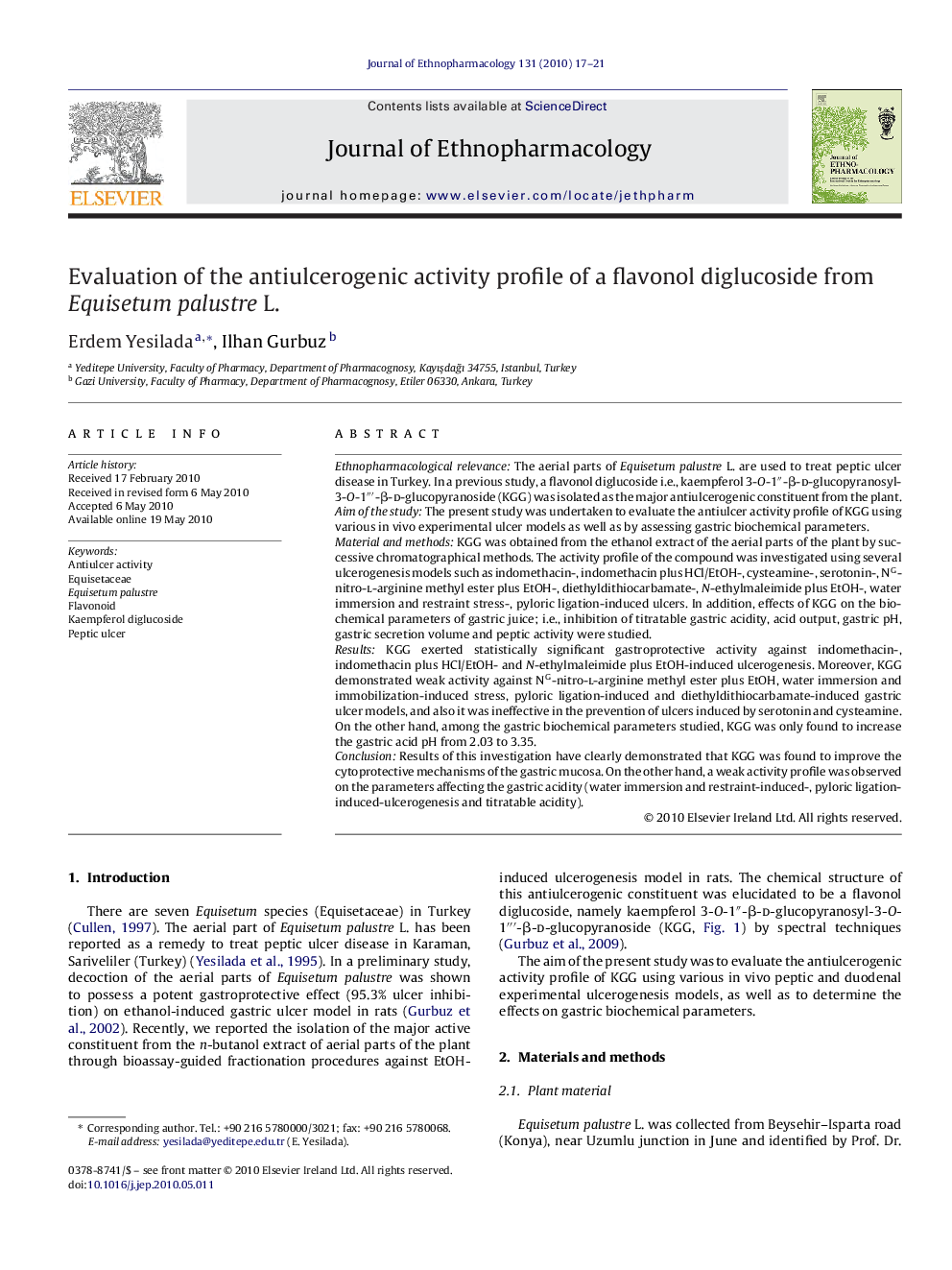| کد مقاله | کد نشریه | سال انتشار | مقاله انگلیسی | نسخه تمام متن |
|---|---|---|---|---|
| 2546204 | 1124019 | 2010 | 5 صفحه PDF | دانلود رایگان |

Ethnopharmacological relevanceThe aerial parts of Equisetum palustre L. are used to treat peptic ulcer disease in Turkey. In a previous study, a flavonol diglucoside i.e., kaempferol 3-O-1″-β-d-glucopyranosyl-3-O-1″′-β-d-glucopyranoside (KGG) was isolated as the major antiulcerogenic constituent from the plant.Aim of the studyThe present study was undertaken to evaluate the antiulcer activity profile of KGG using various in vivo experimental ulcer models as well as by assessing gastric biochemical parameters.Material and methodsKGG was obtained from the ethanol extract of the aerial parts of the plant by successive chromatographical methods. The activity profile of the compound was investigated using several ulcerogenesis models such as indomethacin-, indomethacin plus HCl/EtOH-, cysteamine-, serotonin-, NG-nitro-l-arginine methyl ester plus EtOH-, diethyldithiocarbamate-, N-ethylmaleimide plus EtOH-, water immersion and restraint stress-, pyloric ligation-induced ulcers. In addition, effects of KGG on the biochemical parameters of gastric juice; i.e., inhibition of titratable gastric acidity, acid output, gastric pH, gastric secretion volume and peptic activity were studied.ResultsKGG exerted statistically significant gastroprotective activity against indomethacin-, indomethacin plus HCl/EtOH- and N-ethylmaleimide plus EtOH-induced ulcerogenesis. Moreover, KGG demonstrated weak activity against NG-nitro-l-arginine methyl ester plus EtOH, water immersion and immobilization-induced stress, pyloric ligation-induced and diethyldithiocarbamate-induced gastric ulcer models, and also it was ineffective in the prevention of ulcers induced by serotonin and cysteamine. On the other hand, among the gastric biochemical parameters studied, KGG was only found to increase the gastric acid pH from 2.03 to 3.35.ConclusionResults of this investigation have clearly demonstrated that KGG was found to improve the cytoprotective mechanisms of the gastric mucosa. On the other hand, a weak activity profile was observed on the parameters affecting the gastric acidity (water immersion and restraint-induced-, pyloric ligation-induced-ulcerogenesis and titratable acidity).
The present study was undertaken to evaluate the activity profile of antiulcerogenic flavonol diglucoside kaempferol 3-O-1″-β-d-glucopyranosyl-3-O-1″′-β-d-glucopyranoside, obtained from Equisetum palustre L. (Equisetaceae). Various in vivo experimental ulcer models as well as gastric biochemical parameters were used for evaluation. Results have clearly demonstrated that KGG was found to improve the cytoprotective mechanisms of the gastric mucosa.Figure optionsDownload as PowerPoint slide
Journal: Journal of Ethnopharmacology - Volume 131, Issue 1, 19 August 2010, Pages 17–21